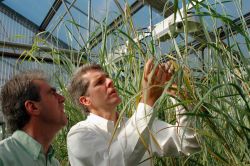 The American soybean industry is crying foul over Argentina’s practice of taxing its whole soybeans for export at a higher rate than it taxes its soybean meal, oil and biodiesel destined for foreign markets. And this article from Feedstuffs.com says the United Soybean Board (USB) believes that is costing the U.S. soybean industry up to $500 million each year:
The American soybean industry is crying foul over Argentina’s practice of taxing its whole soybeans for export at a higher rate than it taxes its soybean meal, oil and biodiesel destined for foreign markets. And this article from Feedstuffs.com says the United Soybean Board (USB) believes that is costing the U.S. soybean industry up to $500 million each year:
The soybean checkoff-funded study found that the lower tax burden on Argentina’s soybean meal, oil and biodiesel creates a strong economic incentive for processing soybeans in Argentina. The country then exports these value-added products rather than whole soybeans. Argentina represents the third-largest soybean-producing country behind the United States and Brazil, but is now the biggest exporter of processed soybean products such as soybean meal, oil and biodiesel. Figures from the study show Argentina exports 99% of its soybean meal and 93% of its soybean oil in an average year.
LMC International, an independent economic and business consultancy serving agriculture, conducted the study for USB. It concluded that if the different tax schemes never existed, the United States would have invested more heavily in soybean crushing capacity with an eye on export markets, which would have boosted U.S. soybean prices.
Americans representing U.S. oilseeds interests point to Brazil’s elimination of its differential export taxes in the mid-1990s and the corresponding dramatic drop in that country’s share of value-added soybean meal and oil exports as proof of that the Argentinian lower tax burden is having an impact on world soybean oil markets.





 The nation is moving slowly but surely toward greater energy independence, according to a
The nation is moving slowly but surely toward greater energy independence, according to a 




